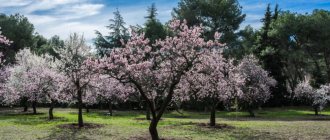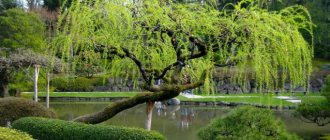11.11.2019 Michur Ivanov Garden and vegetable garden The basics of landscape design involve the use of not only flowers and shrubs, but also trees. Sumac (vinegar tree) is ideal according to the description and photo for decorating the landscape; planting at home and care without harming the plant are simple and understandable even for novice gardeners.
Features of sumac
The Sumakh genus is represented by 250 species: wild and ornamental deciduous trees and shrubs. Sumacs with poisonous leaves and shoots are found in North America.
Advantages and benefits when growing:
- Survives severe frosts, drought and heat, even without watering.
- There is no predilection for fertile soil; sumac agrees to tolerate poor, rocky and dry soils.
- It produces a lot of shoots, which makes reproduction easier.
- Thanks to the branched roots and shoots, it prevents the soil from collapsing and weathering and inhibits the sliding of soil layers.
- Staghorn sumac emits a musky odor, which mosquitoes do not like.
- Decorates the site all year round.
The main and only disadvantage of growing sumac is its rapid growth, which makes care more difficult. Other plants nearby will wither and die. Another rare disadvantage is the accidental planting of a poisonous plant.
Reproduction
Sumac has one drawback, which has to be fought when the tree is already growing in the garden. This tree is characterized by active growth of roots, as a result of which there is always a lot of growth around it, which has to be constantly removed.
However, it is precisely this disadvantage that acts as a huge advantage when it is necessary to propagate a tree. Sumac can be propagated vegetatively. At the same time, young seedlings easily take root in their new habitat.
If it is not possible to obtain a seedling yourself, you have to purchase it from markets or nurseries. When choosing a seedling, you need to visually inspect:
- leaves to ensure that there is no damage on them, and also to ensure that they are in the correct shape;
- crown, assessing whether it is symmetrical;
- root system consisting of smooth and well-developed roots.
Many plants are propagated using seeds. Sumac is no exception; you can also use this method. However, this method is significantly inferior to propagation using seedlings. In addition, the propagation procedure by seeds is accompanied by several disadvantages:
- The germination of collected seeds lasts only for 4 years;
- after planting the seeds, the maximum percentage of germination is no more than 2%;
- young shoots grown from seeds are characterized by a low level of viability;
- When planting sumac seeds, preparatory work is required (two months of stratification, treatment with concentrated sulfuric acid, scalding with boiling water).
Description of staghorn sumac
The height of garden species is 3-5 m, although wild representatives reach 10 m. Up to 3 years it is an upright tree with sparse branches. With age, trunks and a lush crown are added - umbrella-shaped, openwork or rounded.
The bark of fresh, gray-brown shoots is soft and velvety to the touch, similar to young deer antlers, which is why this sumac was called fluffy or staghorn sumac.
The leaves are complex, reminiscent of a palm tree, up to 50-55 cm long, on which up to 30 leaf blades grow. The plates are 11-15 cm long, velvety, pointed and with jagged edges, the underside is white. In autumn, the leaves turn bright red, purple or scarlet.
It begins to bloom in May and ends in July. Cone-shaped paniculate inflorescences 10-20 cm long grow at the ends of the branches. Female flowers are painted in a bright red-crimson color, while male flowers have a yellow-green tint. By autumn, the female inflorescences are covered with red fluff, in which the seeds are hidden.
Care
Sumac, like any other plant, needs care, which involves performing the following actions:
- Watering. Dry periods do not pose any particular danger to the vinegar tree. However, gardeners recommend watering the tree once or twice a week in the absence of rain, avoiding waterlogging of the soil. In this case, it will be possible to create optimal conditions for lush flowering and active growth of sumac.
- Feeding. If desired, you can use mineral fertilizers as a top dressing, excluding nitrogen-containing options. However, fertilizers can be applied no more than once a year. The tree grows easily without applying fertilizers, but their abundance can provoke the death of the tree. For this reason, gardeners recommend applying fertilizers with extreme caution.
- At the beginning of spring, sanitary pruning is carried out, the purpose of which is to remove damaged branches. The top of the tree is often damaged when exposed to too low temperatures. You can remove damaged branches without fear, since new ones will appear in their place very quickly.
- Loosening the soil. The soil around the trunk is loosened and weeds are removed. The actions are performed carefully so as not to damage the root system.
- Preparing for the winter period. An adult sumac easily withstands severe frosts, so it does not need shelter at all. In contrast, young, immature seedlings need to be covered using spruce branches.
- Pest and disease control. Gardeners welcome such a tree because it is very rarely susceptible to diseases, and even in winter, the tree bark does not attract the attention of rodents. However, if over-watered, sumac can be affected by powdery mildew. A sign of damage is a white coating on the leaves, branches and trunk. To combat powdery mildew, you need to purchase special chemicals and treat the affected areas with them.
So, based on the description and photo, many gardeners like the vinegar tree, who can plant sumac on their own at home and provide proper care without harming the plant.
Author: Vladimir
Source: mainavi.ru
garden and vegetable garden, vinegar tree
Planting and propagation
Growing vinegar sumac (staghorn sumac) is not difficult - the plant easily adapts to soil, care and climate, but does not tolerate a lack of lighting. When purchasing a seedling, you should pay attention to the symmetry of the crown and the neatness of the leaves. Also inspect the integrity and development of the roots.
For planting, choose a sunny, not windy place, so that there are no other trees nearby or close groundwater. Even acidic, rocky and brackish soil is suitable, the main thing is a dry and drained area, with not heavy and not dense soil. River sand and humus are often added to garden soil.
Purchased 2-year-old (not younger) trees are grown like other seedlings: they dig holes the size of a root ball, add humus or compost and sand, pour in water and dig in, thoroughly tamping the soil.
It is advisable to plant female and male plants at once. The distance between the trees is left 2-2.5 m. To prevent the growth of shoots, material is dug into the ground, simultaneously with planting, to limit the growth of roots. Sumac begins to bloom after 2-3 years, and lives for more than 20 years.
I propagate staghorn sumac by daughter offspring, choosing a strong, tall and healthy plant. Use a shovel to cut off the mother root and dig it up.
The second option is seeds. Used to develop a new variety or in the absence of seedlings. To dissolve the thick peel, you will need concentrated sulfuric acid, where the seeds are placed for 50 minutes, then immediately scalded with boiling water. Germination rate is 2%. The sprouts that appear a month later are weak and painful, from which it is difficult to grow a seedling.
If the seed has rotted on the ground on its own and the sprout has taken root, you should not touch it, but let it grow. After 2 years, transplantation is permitted.
How to plant sumac
Autumn is the best time to plant an ornamental tree.
It is advisable to choose a place in the garden for it that is sunny, protected from the wind, with well-drained soil, since it does not accept the roots getting wet. In terms of other growing conditions, sumac is a real Spartan. It will grow on fertile loams and on poor sandy or rocky soils, it is suitable for alkaline and slightly acidic environments, it is resistant to diseases and pests, and can easily tolerate heat, drought, and frosty winters. And even if it freezes slightly, it always recovers.
When planting, you need to take into account two important features of the plant.
- Sumac produces abundant growth. And if you don’t want it to spread throughout the garden and crowd out other crops, immediately provide restrictions for root growth. To do this, dig a special root barrier or plastic border into the soil to a depth of at least 50 cm. This is done along the perimeter of the crown at a distance of 1.5–2 m from the trunk, so that the roots have room to grow.
- Sumac is a dioecious crop. If you want to have a lot of fruits, plant at least two vinegar trees nearby.
When planting in the fall, it is advisable to insulate the root zone with fallen leaves and spruce branches so that the plant is guaranteed to overwinter and grow.
The vinegar tree grows very quickly, increasing in height and width by 30–40 cm annually.
How to properly care for staghorn sumac
It is necessary to loosen the soil around the sumac trunk, but keep in mind that the roots are located close to the surface and occupy a horizontal plane. In addition, it is necessary to regularly cut down young growth.
Sumac is not afraid of drought, but in order for the plant to grow many flowers, it is watered, without over-watering, weekly.
The soil around young plants is mulched, adding a layer of 6 cm.
Feed sumac once a year after winter with nitroammophos, but in moderation. Nitrogen-containing fertilizers should be avoided.
In the spring, sanitary pruning is done, removing damaged branches, which will soon be replaced by new shoots. If desired, other branches are trimmed to form a bush.
Adult plants are not covered for the winter, but seedlings need to be covered with spruce branches.
Sumac rarely gets sick; rodents do not gnaw its bark. The only problem is powdery mildew or gray rot, but only with excessive moisture. In this case, you should first get rid of the damaged parts, then treat them with a fungicidal preparation.
Features of tree care
Another good thing about vinegar tree is that it requires virtually no maintenance.
Water it only in case of extreme heat and prolonged drought. The plant also does not need fertilizing. Although if you see that the growth is insufficient, in the spring you can add humus or vegetable compost to the ground around the trunk. This will give the tree a good start.
Sumac does not require annual pruning, although it is not afraid of it, since it grows back quickly. Usually in the spring, sanitary cleaning of the crown is carried out, removing frozen branches. They also shape the plant by shortening shoots that are too extended.
Due to its high plasticity, the vinegar tree can be grown on a trunk, formed into a multi-stemmed tree or shrub.
Since the plant is prone to the formation of shoots, it is not recommended to loosen the soil in the root zone. By damaging the roots, you thereby stimulate the appearance of young trees. By the way, the same can be said about excessive feeding. The better you take care of the tree, the more abundant its growth will be.
In order not to loosen the soil, it is best to sod or mulch the root zone with decorative crushed stone. If shoots appear and need to be removed, cut the shoots at the level with the soil, but do not dig them up, otherwise you will get several instead of one tree.
The best way to avoid overgrowth is to cover the tree trunk with grass and keep the plant “hand to mouth”
Fluffy sumac as decoration
Gardeners and designers like staghorn sumac for its year-round decoration of the site, originality of appearance and ease of care. Spring foliage delights with fresh greenery; by autumn it turns red, brown, orange and pink.
Sumacs are planted on alpine hills, used to decorate rockeries, spacious lawns, Japanese and rocky gardens. The bright autumn foliage of sumac sets off the coniferous trees. Group plantings will reliably strengthen and decorate a slope or play the role of a hedge.
Sumac tree: features and types of plant
Among the many ornamental trees, sumac occupies a special place. It is distinguished by beautiful leaves and extraordinary inflorescences, which delight all passers-by from early spring to late autumn.
With proper care, the vinegar tree can grow for 20 years.
Plant types:
- Sumac is fragrant. It is presented in the form of a creeping bush. Fragrant sumac grows up to 1 m in height, some branches can reach 3 m. It grows very slowly, but it always has a beautiful appearance. The first flowering can be observed only 5 years after planting. At the end of June, pyramids appear on the branches, which have a white tint.
- Sumac naked. It is distinguished by a bushy tree and large variegated leaves, the lobes of which reach 12 cm in length. The entire plate grows up to 50 cm. In summer they are a rich green hue, but with the onset of autumn they turn orange. Sumac grows up to 3 m tall. The crown is umbrella-shaped. The branches are bare. Flowers appear on them in the form of panicles of white and red shades. They grow about 20 cm long. At the end of flowering, round fruits are formed, which are slightly flattened and pubescent. They remain on the tree throughout the winter.
- Sumac is fluffy. In our latitudes, this species is called vinegar tree. The plant is distinguished by its variegated foliage and colorful crown. In the wild it grows up to 10 m, but on site its height rarely exceeds 5 m. Young specimens are straight with a small number of branches. Adults become relaxed and quite curvy. The branches of the vinegar tree are light and thick. The leaves combine several lobes, each of which reaches 12 cm. Flowering in this species also occurs in June. The inflorescences are large and colorful. They have a red tint.
There are several varieties of downy sumac. They differ in the shape of the crown and the color of the leaf blades.
For use in cooking
From the ripened drupes of the plant, a spice is prepared, which is also called sumac, which tastes similar to vinegar or lemon. The seasoning, ruby or red in color, is used more often in the Middle East, by Asians and Caucasians. To prevent color loss, use vegetable oil to season food. The shelf life of dishes with sumac increases.
The original spice is added to the marinade, flavored in vegetable salad to enhance the taste of other spices, and added to drinks, minced meat and sausage. Also used for sprinkling chicken, fish, and legume dishes. Sumac is added to pilaf, shashlik and kebab.
Features of cultivation
If planting a crop does not present any difficulties, then in order to grow a beautiful tree it will have to be provided with some care.
Note: One of the most valuable properties of sumac is its unpretentiousness. This tree can develop normally without additional care. However, following some rules of agricultural technology will help increase the decorativeness of the tree and speed up its growth.
To ensure that sumac pleases you with its appearance, it is advisable to follow these recommendations:
- It is advisable to plant and replant seedlings in the spring so that the plant has time to take root in a new place and get used to its growing environment before the onset of cold weather.
- Large seedlings and planting material with a closed root system can be planted at any time of the year, except winter. The main thing is that the air temperature is positive.
- It should be remembered that this exotic plant has a very well developed root system. Due to this, young shoots regularly form around an adult tree, which will have to be trimmed regularly. In addition, the plant can suppress neighboring plants in the garden. To prevent this from happening, the area where sumac grows is artificially limited by digging slate sheets deep into the ground.
Figure 4. The culture is unpretentious and does not require special care.
If the site for planting the plant was chosen correctly, and the sumac received optimal care, the first flowers will appear already in 4-5 years of life. In this case, a tree can grow and develop successfully in one area for 20 years or more (Figure 4).
Staghorn sumac: growing from seeds
In most cases, already grown and strengthened seedlings are used to grow this exotic tree. But some gardeners prefer the seed method.
Note: Using this method is associated with certain difficulties, since the seeds take a long time to germinate and their germination rate is insignificant.
The seeds of the vinegar tree are enclosed in a dense and thick skin, so they necessarily need stratification. But even after this procedure there is no guarantee that the shoots will be friendly and abundant.
In specialized nurseries, sulfuric acid is used to treat seeds. This substance dissolves the shell well and the planting material sprouts. But, even if you managed to get a seedling, this does not mean that it will transform into a full-fledged tree. Sumac sprouts often get sick and can die from unfavorable climatic conditions, so they need to be provided with high-quality greenhouse conditions.
The use of sumac in folk medicine
Staghorn sumac leaves and bark are rich in healthy omega-3 fatty acids and vitamin C.
Medicinal properties:
- diuretic and antifungal agent;
- antioxidant qualities;
- prevents the development of diabetes and cardiovascular disorders;
- Wash wounds after burns and weeping ulcers with the infusion, rinse the mouth to relieve toothache and wash the eyes;
- for the treatment of skin diseases and boils;
- The decoction eliminates nausea, vomiting, and stops internal bleeding.
To prepare the infusion, pour one glass of boiling water into fresh leaves (1 spoon) and infuse for 1 hour. Take 1 tbsp. spoon three times a day.
To prepare a decoction, take 10 parts of plant material and 100 parts of water. Used as compresses, added to the bath, and rinsed the mouth.
A water infusion of sumac seeds helps in the treatment of diabetes. Grind the fruits and take 1 spoon of powder, stir in 1 glass of hot water. Leave for 60 minutes. and take 30-60 ml in 30 minutes. before meals three times a day.
Landing rules
Initially, young seedlings are grown in more favorable conditions than outdoor ones. Young seedlings grow in prepared containers for two years. During this period, they have time to get stronger, after which they are planted in the garden, having previously chosen a suitable place. It is not recommended to keep in artificial conditions or grow in containers for more than three years.
Spring and autumn are suitable periods for planting young seedlings in the garden. However, most gardeners prefer spring planting, arguing that in spring the conditions for plant growth are as favorable as possible, and seedlings take root and take root more easily.
The landing procedure involves the following steps:
- Prepare a soil mixture consisting of sand (2 parts), compost and earth (1 part each). The prepared mixture makes the soil light and loose; it is with these characteristics that the seedlings quickly and painlessly adapt to new conditions.
- Dig holes according to the number of seedlings that are planned to be planted.
- Pour a sufficient amount of water (about 10 liters) into the wells and wait until the water is completely absorbed.
- A young seedling is placed in the center of the hole and all the roots are carefully leveled.
- The root collar of the seedling is deepened by 5 cm.
- The planted seedling is sprinkled with prepared soil mixture, each layer is lightly compacted to prevent the occurrence of voids.
- When planting several seedlings, the holes are made at a sufficient distance so that the spreading crowns of adult trees do not interfere with each other (optimally, a distance of about four meters should be maintained between two seedlings).
- The seedlings are watered and mulched abundantly to prevent rapid evaporation of water (mulching will also avoid damage to the roots when loosening the soil).
It is important to know that sumac is a type of dioecious plant. Given this feature, male and female trees need to be planted side by side.
In order to prevent young growth from growing over an area, many gardeners immediately build special “limiters” during planting. They can be made from scrap materials, for example, slate or metal sheets. Such materials are dug deep into the ground around the planted young seedling.
Types of vinegar tree
Nature has created more than a hundred varieties of sumac. However, a person cannot use all the variety for decorative purposes, for two reasons:
- to preserve its natural beauty, the tree needs a large area;
- There are also poisonous specimens in the sumac family; simply touching the leaves results in burns on the skin.
The following varieties are recognized as decorative:
- The staghorn specimen can be distinguished from others only by its leaves: the denticles surrounding the leaf blade are quite deep. In the “Dissecta” variety, the leaves have a silvery tone, like those of a fern.
- Fragrant sumac is a large shrub that grows for a long time. The variety does not bloom for the first five years, but in subsequent years it attracts with its spectacular openwork pyramids in the second month of the summer season.
- Bald sumac can be confused with the first variety, staghorn sumac. This is a rather highly branched tree, the crown resembles a spreading bush. Quite large leaves - almost half a meter in length. The inflorescences are just as large - up to twenty centimeters. Leaf color - noble copper. During flowering, the plant is covered with male and female flowers: snow-white panicles and scarlet flowers. The specimen is quite interesting: the tree can bloom a second time. Bright flowers appear again among the bulging ripening autumn fruits
How to plant seedlings correctly
Planting is carried out in Vienna or in the fall.
Seedlings must be at least 2 years old. To begin, prepare the dimple. Its dimensions should be the same as an earthen ball around the root system. Mix the soil from the hole thoroughly with a shovel of compost. This is necessary so that the young plant takes root well and quickly.
Place the seedling in the hole. Spread the roots well around the entire perimeter of the recess. Then fill the empty space with prepared soil.
If you plan to plant several trees at once on one site, then you should remember that the distance between trees should be at least 2.5 m.
Planting process
Planting sumac from seed
There is practically nothing difficult about such a landing. Having dug a shallow hole (15*20 cm), place some fertilizer mixed with soil in that place, lay in a seed, and dust it well with soil.
However, you need to watch for seedlings for about a month. If you choose this method, you must not forget that the hard skin of the seed must be damaged before planting in order for the sprout to emerge. Otherwise, it probably won't get through the thick skin. Many professional gardeners consider growing sumac from kernels a big mistake. Such plantings are most often unhealthy and unviable. Caring for young trees grown from seeds requires special conditions. This process is often very difficult for those who have been interested in gardening for a short time.
Preparing to plant a seedling
Based on the size of the roots, the recess for planting should be at least 40 by 40 centimeters. Before placing the seedling there, a mixture of earth and humus is poured into the hole, and a bucket of water is poured. Planting should be done only after the water has completely entered the ground. You need to fill the plant at the mark where it grew before.
As a rule, it is clearly visible. Already planted sumac is watered again in the root formation area. Sumac does not require fertilizers, but when applied, it will take root and grow much faster. In the future, it may reward the gardener with flowering and a luxurious crown.
Growing a seedling
It is not so difficult to obtain, since you can use young shoots that produce roots. To do this, just take a closer look at the healthiest of them and dig them out using a shovel with a sharp edge. Due to the fact that the plant not only grows from the root, but also gets nourishment from it, it is advisable to dig deeper.
If a young tree is not planted immediately: it needs to be transported or simply postponed planting for a couple of days, it is necessary to carry out several procedures to preserve it. Place the young roots in a plastic bag, before wrapping them in wool or adding sawdust to the root level in the bag. This will reduce the risk of defects and drying out roots. They can be kept under these conditions for up to 6–8 days.
Wintering sumac
Despite the fact that staghorn sumac freezes slightly in the middle zone, it does not need protection for the winter and grows well without any shelter. The shoots of this tree have time to lignify only 2/3 of their length, but it quickly recovers and traces of winter damage are practically invisible on the vinegar tree.
Staghorn sumac, or downy sumac, Vinegar tree (Rhus typhina). © Mirage Bookmark
“Deer in the Garden”, or Staghorn Sumac
Unfortunately, we do not perceive winter as a full-fledged gardening season. But well-planned areas are extraordinarily beautiful in the snowy season! Imagine, on a frosty morning you go out of the house into the garden to take a deep breath of fresh air. The snow sparkles in the sun... And your mood immediately lifts with a feeling of vigor. Then the gaze focuses on individual details. Here are the “deer horns” sticking out from under the snow... Deer in the garden? Yes, these are shoots of staghorn sumac! I just want to stroke them and feel the thick fluff under my hand.
England can be proud of the rich history and culture of creating winter gardens. The botanical gardens of Cambridge University and Anglesey Abbey reach their peak of decorativeness in winter.
It turns out that staghorn sumac (Rhustyphina) is a “native” of North America. For a long time, the Indians used it “in the household”: they prepared a sweet and sour drink from crushed fruits, and used the bark and leaves, rich in tannins, for tanning leather.
Growing up to 4 meters in height, the “deer sumac” scatters branches and antlers wildly, as if trying to occupy as much space as possible. And in the Dissecta variety, branches with numerous shoots descend to the very ground.
Beauty in winter and summer!
Sumac is effective at any time of the year. In spring, its crown is a green lace umbrella of long, velvety, gracefully curved leaves. At the beginning of summer, this umbrella is decorated with large candle inflorescences of two types: loose male ones with yellowish-green flowers and dense female ones with bright red flowers. Blooming sumac exudes a refreshing, vinegary aroma with hints of cucumber vine, attracting insects from all over the area. Because of this aroma, the plant is also called “vinegar tree.” By autumn, sumac looks even more interesting thanks to the bright foliage of all shades: fiery orange, scarlet, carmine, purple... And in winter, the tree is given an original look by the “velvet” texture of light brown shoots, on which bright clusters of fruit-cones with dark - red fluff.
No worries!
Sumac is resistant to air pollution and is so unpretentious that it can grow not only on poor soils, but even on rocky limestone, which is completely unsuitable for farming. Moreover, its strong roots anchor the soil of ravines and screes. The vinegar tree does not require watering (only young plants are watered, and only in dry weather), and tolerates slight shading, although it prefers sunny places. An adult sumac does not suffer from anything, and parasites do not live on it.
And I don’t care about the frost!
Staghorn sumac can withstand cold temperatures down to -30 ºС. But even if the ends of its branches freeze, the plant will quickly recover. It turns out that frosts act as formative pruning, “shortening” long shoots and forcing them to branch. As a result, the tree becomes denser.
The only disadvantage of the plant is its fragility - it lives for a maximum of 20 years. True, sumac quickly “reborn” from the root shoots and even becomes an aggressor, seizing territories at a great distance from the mother tree.
Using an exotic plant
Staghorn sumac is very popular among landscape designers due to its uniqueness, beauty and ease of care. The tree can be called a chameleon. In spring it captivates with its attractive green foliage; with the onset of autumn, the foliage darkens and changes color to brown, red, and orange. An unsurpassed decoration of any garden and park, it pleases the eye with its presence throughout the season.
It is worth planting if there is a large free space. Not a single plant gets along nearby. Sumac strengthens slopes and soil prone to erosion. They are contemplated in alpine hills and rockeries. They look great on flat areas and large lawns, next to coniferous plants.
Description of the variety and variety of sumac
In our country, a tree rarely grows very tall; usually its height is limited to 3 meters.
By the age of 10, staghorn sumac stops growing upward and begins to actively expand in breadth. The crown volume can reach a diameter of 6–8 m. To verify this, look at photos of mature trees. The branches of Staghorn Sumac bend intricately and form funny openwork weaves, which are clearly visible in winter when the plant sheds its leaves. The shoots are covered with short pile, externally reminiscent of deer antlers. It was this feature that gave rise to its name. However, old branches lose this decorative property and become smooth.
Designers love staghorn sumac for its beautiful leaves.
The leaves are imparipinnately compound, collected in 11-31 pieces. Each leaf can reach a length of 10 cm. The inflorescences are collected in panicles; during the flowering period they have a very inconspicuous appearance, but after the fruits ripen, their decorative peak reaches its peak. In autumn, the foliage turns crimson and the inflorescences take on the appearance of beautiful cone-shaped candles that last all winter. The tree really becomes the pride and decoration of the garden.
In addition to staghorn sumac, there are other varieties:
- sumac naked. The differences are only in the appearance of the bark; it lacks fleecy pubescence.
- Fragrant sumac has an incredible smell. A pleasant thick aroma, as if enveloping the planting site with a veil. It differs from the previous 2 species in the shape of its foliage.
All these varieties are non-poisonous, have high decorative value and can be successfully grown in open ground on private plots and in parks. Starting from the 3rd climate zone. To choose the best option for yourself, look at the photos of plants.











